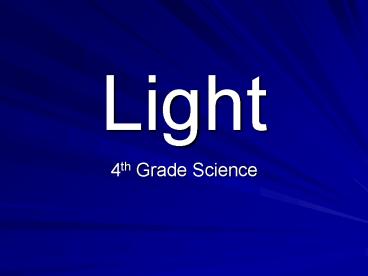Light - PowerPoint PPT Presentation
1 / 19
Title:
Light
Description:
If white light is passed through a prism, ... Refraction When light is refracted it passes from one type of transparent material to another, and changes direction. – PowerPoint PPT presentation
Number of Views:405
Avg rating:3.0/5.0
Title: Light
1
Light
- 4th Grade Science
2
The Basic Properties of Light
- Brightness
- Colors
- Being visible
3
Brightness
- The intensity of light or brightness of light is
related to the amount of light being seen. - The closer the source of the light is, the
greater the intensity or degree of brightness. - The greater the distance the source of the light
is, the lesser the intensity or brightness.
4
Color
- Light, or white light, is made up of all colors
of light mixed together. - If white light is passed through a prism, it can
be separated into light of different colors. - The colors are red, orange, yellow, green, blue,
indigo, and violet. - These are the colors seen in a rainbow.
5
The prism does not create new colors, but merely
separates the colors that are already there.
6
(No Transcript)
7
The most common example of a spectrum is a
rainbow!
- The rainbow is caused by sunshine (white light)
shining on water droplets that are in the air
just after a summer shower. - Thousands of these water droplets break up the
light, just like Sir Isaac Newton's prism. - Can you make a rainbow? Of course! Make your own
rainbow by turning on the garden hose, which has
a nozzle that will make a fine mist, or spray.
Make sure the sunlight is coming over your
shoulder. You have made a rainbow.
8
Visible
- In order for an object to be visible, it must
either give off its own light (be a source of
light) or it must reflect light. - The Sun, a candle flame, or a flashlight gives
off visible light. - The Moon and many objects around us reflect light
in order to be seen.
9
Light is made of colors!
- The different colors of light are revealed when
white light is passed through a prism and - separated into the different colors of the
rainbow, called the spectrum. - These colors are related to the different
amounts of energy in white light. - Each color represents a different amount of
energy.
10
Light is a form of energy!
- Energy
- Energy is the ability to make something move,
happen, or change.
11
Light travels in a straight line away from the
lightsource.
12
Reflection
- When light is reflected, it bounces back from a
surface. - Reflection allows objects to be seen that do not
produce their own light. - When light strikes an object, some of the light
reflects off of it and can be detected by eyes. - When light strikes a smooth, shiny object, for
example a mirror or a pool of water, it is
reflected so that a reflection can be seen that
looks very similar to the object seen with light
reflected directly from it. - The color of the light that is reflected from an
object is the color that the object appears. For
example, an object that reflects only red light
will appear red.
13
Refraction
- When light is refracted it passes from one type
of transparent material to another, and changes
direction. For example, when light travels
through a magnifying glass, it changes direction,
and we see a larger, magnified view of the
object. - When a straw is viewed in water, light passes
from the water to the air causing the path of the
light to bend. When the light bends, the straw
appears distorted (bent or broken)
14
Absorption
- When light is absorbed it does not pass through
or reflect from a material. It remains in the
material as another form of energy. - The colors of objects are determined by the light
that is not absorbed but is reflected by the
objects. - All other colors of light striking the object are
absorbed by the object. - A red object, for example, reflects red colors of
light and absorbs all other colors.
15
Light can travel through transparent material and
even through empty space. Theway that light
reacts when it strikes an object varies with the
object.Light behaves differently when it
strikes different typesof materials.
16
Transparent
- A transparent material allows light to pass
through it because it is not absorbed or
reflected. - Objects can be seen clearly when viewed through
transparent materials. - Air, glass, and water are examples of materials
that are transparent.
17
Translucent
- A translucent material scatters or absorbs some
of the light that strikes it and allows some of
the light to pass through it. - Objects appear as blurry shapes when viewed
through translucent materials. - Waxed paper and frosted glass are examples of
materials that are translucent.
18
Opaque
- An opaque material does not allow light to pass
through, light is either reflected from or
absorbed by an opaque material. - Wood, metals, and thick paper are examples of
materials that are opaque.
19
http//www.brainpop.com/science/energy/light/Ot
her videos to check outcolorrefraction and
diffractionelectromagnetic spectrum































